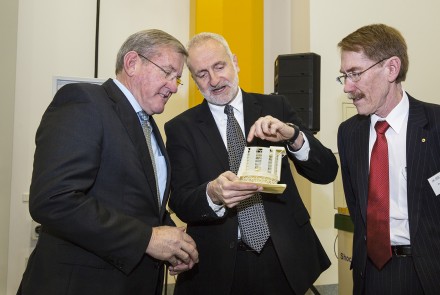Space Engineering facility takes off

Australian space scientists will no longer need to go offshore to build satellites, following the completion of the Advanced Instrumentation and Technology Centre (AITC) at The Australian National University.
The Minister for Industry, Ian Macfarlane officially opened the Centre.
“Australia is doubly blessed because Mt Stromlo also has a long heritage of combining scientific and engineering excellence to design, manufacture and test the high precision instruments which support cutting edge research that I think we often take for granted in Australia but which we should always be proud of,” Mr Macfarlane said.
The space sector generates up to $1.6 billion in revenue every year and employs over 4,000 scientists, engineers, policy makers and support personnel.
During the opening, Minister Macfarlane announced that ANU has signed two major contracts totalling over $11 million for projects at the AITC.
ANU has snared a $5 million design contract for one of the first instruments to be installed on the Giant Magellan Telescope (GMT), the GMT Integral Field Spectrometer.
“This will help find answers to questions about such cosmic mysteries as the formation of galaxies, dark matter and dark energy,” Mr Macfarlane said.
Research School of Astronomy and Astrophysics Director Professor Matthew Colless said the instrument will significantly advance the science.
“This is going to be a fantastic facility that will take full advantage of the giant mirror and give us images that are ten times sharper than the Hubble Space Telescope.”
The second contract is a $6.4 million project to develop a space junk tracking system for the Korean Astronomy and Space Science Institute. Researchers at ANU are providing technological support for industry partner EOS to build an adaptive optics system for a ground-based telescope system.
Professor Colless said the contracts will lead on to more work for the AITC.
“We expect a $20 million or thereabouts construction contract will follow on from the design contract,” he said.
Professor Colless said the track record of achievements was the key to the lucrative contracts.
“We have new capabilities that others didn’t have. We’re fortunate that we have fantastic people who here who are giving us that edge.”
The AITC has the only facilities in Australia that enable the engineering of equipment right from the design stage through to being launch-pad ready.
Professor Colless said the AITC will provide a hub for Australia’s space industry.
“Australia has many small to medium enterprises in the space industry. We want to enable them to get together to take on larger projects” he said.
Since the launch of Stage One of the Centre in 2006, the AITC has been the base for major collaborations between institutions across the world. The ANU is leading Australia’s participation in the Giant Magellan Telescope and is involved with development of a spacecraft plasma thruster system. It is also supporting a satellite laser ranging system for NASA, with industry partner EOS.
The event concluded with Professor Colless presenting Minister Macfarlane with a 3D printed model of the Giant Magellan Telescope.
 Follow
Follow